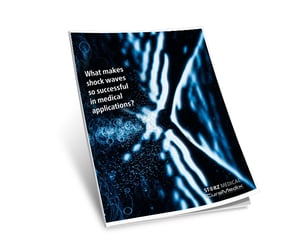 Satisfy your intellectual curiosity about the science behind shockwave treatment (also known as EPAT or ESWT) with this complimentary, highly informative white paper, What Makes Shockwaves So Successful in Medical Applications. In this resource, you’ll take a fascinating dive into the mechanics of this innovative and proven technology. You’ll read about the distinct characteristics of shockwaves and what distinguishes them from other wave applications you are already familiar with, such as ultrasound.
Satisfy your intellectual curiosity about the science behind shockwave treatment (also known as EPAT or ESWT) with this complimentary, highly informative white paper, What Makes Shockwaves So Successful in Medical Applications. In this resource, you’ll take a fascinating dive into the mechanics of this innovative and proven technology. You’ll read about the distinct characteristics of shockwaves and what distinguishes them from other wave applications you are already familiar with, such as ultrasound.
Did you know the first successful use of shockwaves in medicine dates as far back as 1980? The technology was initially used to non-invasively break apart kidney stones and other calculi. Researchers then theorized that perhaps the shockwaves could also fragment calcified deposits in body tissue. While their initial theory did not pan out, the surprising outcome was improved blood circulation, which led to an intensified metabolism, induced healing and pain reduction.
The exciting field of shockwave treatment was born! And today, the number of known indications is continually growing, including such diverse specialties as orthopedics, cardiology, dermatology, pain therapy, traumatology and neurology.
But how do shockwaves work? Why are they so effective? And why do other types of waves like ultrasound not produce a similar effect? If you’re a science person or even if you aren’t, you’ll enjoy this clear explanation into the science behind the medicine that answers these questions and more. You’ll explore the unique properties that contribute to shockwave treatment results, including:
- The anatomy of a shockwave, such as density, transmission medium and velocity
- The impact of acoustic interface effects like refraction, reflection, scatter and diffraction
- Critical shockwave parameters such as pressure, focus, energy, energy flux density, momentum transfer and mechanotransduction
- How the wave’s unique shape contributes to its effectiveness
- Why shockwaves pass through homogeneous soft tissue masses without major changes, absorption or damage.
Shockwave treatment has led to successful outcomes for a wide range of conditions, including muscular and vascular spasms, trigger point release, angina pectoris, pseudarthrosis, chronic soft-tissue pain, dermatological skin improvement and wound healing. You’ll also get a glimpse into the future of shockwave treatment and the promising indications for treating neurological pathologies such as Alzheimer’s.
With plenty of illustrations and straightforward scientific explanations, this paper is a quick yet in-depth read that’s beneficial to both experienced shockwave practitioners and those newer to the field.
Gain deeper insight into how this fascinating technology is advancing medical treatment across a variety of specialties. Download your copy of What Makes Shockwaves So Successful in Medical Applications today!


